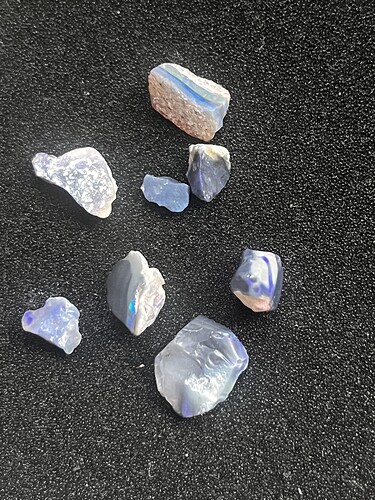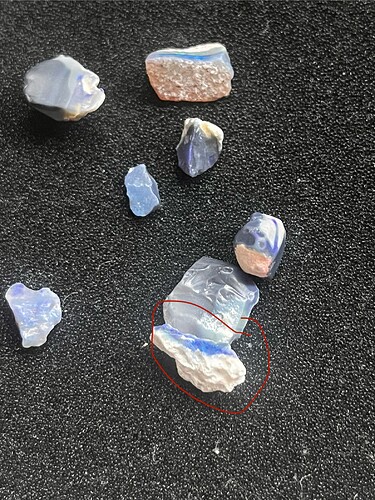Thank you so much for this identifying characteristic, I appreciate all the help I receive on this site! I recently purchased my first Refractometer and I can’t wait to see if it lines up with Hauyne, I think there’s a way to determine if the stone is singly or doubly refractive or birefringent using the refractometer, is that correct? I’m hoping to solve this mystery once and for all, although natural and man-made glass have properties that are extremely close if not overlapping with Hauyne’s. I may return for advice once I get time to play with my new “toy.” Thanks again and I will definitely post my results once I obtain them!
I looked through my collection after re-rereading your post, as I couldn’t shake the thought that I have something similar. I know the shape, and I organize some of the odd shaped stones in my collection by shape, and sure enough, I have some they are similar. These are “black” opals (I think that’s that term) from Australia (the location of last place origin I am certain of, it’s a secondary deposit and they are ancient so who knows where they may have come from). Although the colors are not quite the same, these were, sadly, stored in water before I got them and so they lost a lot of depth of color, but in water, they look nearly the sale. I also noticed what I think is a conoidal fracture type of your stone, which is consistent with opal, and I’m pretty sure opals have been found in that area. So my guess is opal. Let us know how it measures when you get a chance. Nice find, that’s for sure!
Note in the second pic the color of the opal from a side that was covered in muck and not exposed to water.
This post has been around for awhile now but if anyone is interested, I have confirmed that it is actually blue obsidian!!
It may not be Hauyne as I had hoped but I am pleased that it’s not man-made colored glass, but rather natural, volcanic glass.
Oh wow, that’s really interesting. Thank you for posting an update!
If it has been determined to be natural, you may have a very rare and unique specimen coming from the region. Curious to know what diagnostics were used to prove it was natural vs. man-made?
Asking because it would be good to understand how to distinguish between the two. I know some of the common markers to look for, but even they are not deterministic proof. Any information you can provide would be greatly appreciated and some good material for the forum. ![]()
Growing up in the Rockies, there were several places near Gunnison and Buena Vista that we would go looking for obsidian. Living near the only active volcano in Colorado, Dotsero, I would go out there on a regular basis actively hunting for obsidian, but never found any. Later in life, I learned the conditions were not favorable to produce volcanic glass, there. But it was still fun to try. ![]()
Unfortunately, I have not found any references for blue obsidian in Colorado. So any information would be fantastic, if you can share.
Cheers!

